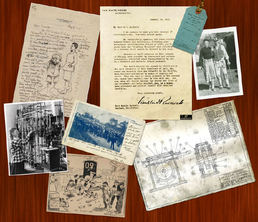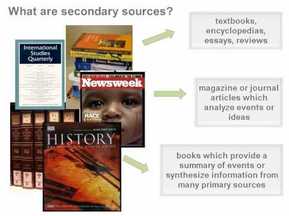Primary and Secondary Sources

What Are Primary Sources?
"Primary sources provide first-hand testimony or direct evidence concerning a topic under investigation. They are characterized by their content, regardless of their format" (Primary Sources at Yale).
Examples of primary sources:
Finding Primary Sources
1. Calisphere "The University of California's free public gateway to a world of primary sources."
2. CIESE Science and Engineering.
3. Digital Library School Access and Digital Library Home Access Explore databases. Primary sources will come up in your search
results.
4. Finding Library Sources Starting points for finding Library of Congress primary source documents.
5. Internet Public Library for Teens and Internet Public Library Use Google Chrome or Firefox browser. IPL does not
display with Explorer. It has an "Ask a Librarian" service for difficult research questions.
6. Library of Congress Access the wealth of our nation's premier library.
7. National Archives A trove of teacher resources and primary source documents.
8. Picturing America US History through art and artifacts.
9. Smithsonian Education Teachers, families and students can find lesson plans and resources linked to CCSS and California
Standards.
10. Smithsonian Institution Archives Materials for K-12 teachers.
11. Thinkfinity Digital resources and a portal to other valuable educational web sites.
12. Web Gallery of Art Virtual museum and searchable database of Western European art.
13. World Digital Library Browse by time period, topic, type of item, or institution.
Teaching with Primary Sources
1. Library of Congress Teachers Classroom materials and professional development to help teachers effectively use primary sources.
2. SOAPS Primary Source Think Sheet Tool for evaluation of primary sources using the SOAPS mnemonic: Subject, Occasion and Audience, Purpose, Speaker
3. Teaching with Documents Lesson plans from the National Archives.
4. Teaching with Primary Sources Using digital primary source materials from the Library of Congress.
"Primary sources provide first-hand testimony or direct evidence concerning a topic under investigation. They are characterized by their content, regardless of their format" (Primary Sources at Yale).
Examples of primary sources:
- Artifacts (coins, plant specimens, fossils, furniture, tools, clothing; all from the
time under study) - Audio recordings (radio programs, podcasts)
- Diaries
- Internet communications on email, list serves
- Interviews (oral histories, telephone, email)
- Journal articles in peer-reviewed publications
- Letters
- Newspapers written at the time
- Original documents (birth certificate, will, marriage license, trial
transcript) - Patents
- Photographs
- Proceedings of meetings, conferences and symposia
- Records of organizations, government agencies (annual report, treaty, constitution,
government document) - Speeches (including transcripts)
- Survey research (market surveys, public opinion polls)
- Video recordings (television programs)
- Works of art, architecture, literature, and music (paintings, sculptures, musical
scores, buildings, novels, poems) - Web site]
Finding Primary Sources
1. Calisphere "The University of California's free public gateway to a world of primary sources."
2. CIESE Science and Engineering.
3. Digital Library School Access and Digital Library Home Access Explore databases. Primary sources will come up in your search
results.
4. Finding Library Sources Starting points for finding Library of Congress primary source documents.
5. Internet Public Library for Teens and Internet Public Library Use Google Chrome or Firefox browser. IPL does not
display with Explorer. It has an "Ask a Librarian" service for difficult research questions.
6. Library of Congress Access the wealth of our nation's premier library.
7. National Archives A trove of teacher resources and primary source documents.
8. Picturing America US History through art and artifacts.
9. Smithsonian Education Teachers, families and students can find lesson plans and resources linked to CCSS and California
Standards.
10. Smithsonian Institution Archives Materials for K-12 teachers.
11. Thinkfinity Digital resources and a portal to other valuable educational web sites.
12. Web Gallery of Art Virtual museum and searchable database of Western European art.
13. World Digital Library Browse by time period, topic, type of item, or institution.
Teaching with Primary Sources
1. Library of Congress Teachers Classroom materials and professional development to help teachers effectively use primary sources.
2. SOAPS Primary Source Think Sheet Tool for evaluation of primary sources using the SOAPS mnemonic: Subject, Occasion and Audience, Purpose, Speaker
3. Teaching with Documents Lesson plans from the National Archives.
4. Teaching with Primary Sources Using digital primary source materials from the Library of Congress.

What Are Secondary Sources?
"... [Secondary sources] are accounts written after the fact with the benefit of hindsight. They are interpretations and evaluations of primary sources" ("Primary, Secondary and Tertiary
Sources").
Examples of secondary sources:
"... [Secondary sources] are accounts written after the fact with the benefit of hindsight. They are interpretations and evaluations of primary sources" ("Primary, Secondary and Tertiary
Sources").
Examples of secondary sources:
- Bibliographies
- Biographical works
- Commentaries, criticisms
- Dictionaries, encyclopedias
- Histories
- Journal articles (depending on the discipline can be
primary) - Magazine and newspaper articles (this distinction varies by
discipline) - Monographs, other than fiction and autobiography
- Textbooks
- Web site (also considered primary
